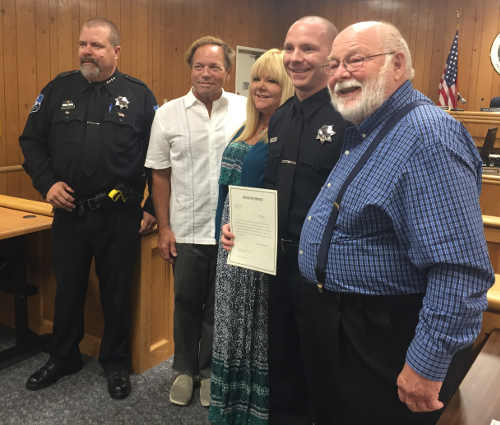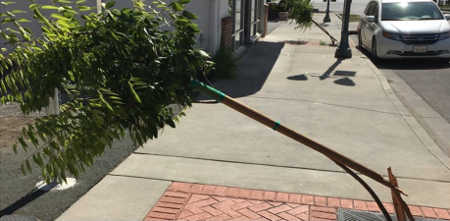- Elizabeth Larson
District attorney, Clearlake Police discuss marijuana issues
CLEARLAKE, Calif. – As efforts move forward at the county level to work on updating local ordinances to allow for permitting medical marijuana cultivation, law enforcement continues to deal with the illegal side of cultivation.
On June 7, the Board of Supervisors held a discussion of Article 72 of the Lake County Code, passed by voters as Measure N in 2014.
A county Medical Marijuana Ad Hoc Committee that includes two supervisors – Rob Brown and Anthony Farrington – along with Sheriff Brian Martin, District Attorney Don Anderson and several other key department heads proposed a series of changes centering in particular around permitting to be in line with new state rules.
The board has sent consideration of those updates to the Lake County Planning Commission, which will hear them next on July 14.
That discussion came just a few weeks after Clearlake Police officials updated the Clearlake City Council on the latest developments regarding the criminal aspects of marijuana cultivation in the city so far this year.
Police say their activities are separate from a marijuana permitting process the city put in place with an updated ordinance earlier this year.
The presentation begins at the 3:51 minute mark in the video above.
Clearlake Police were joined before the Clearlake City Council for the May discussion by District Attorney Don Anderson, who shared information he gathered during a trip earlier this year to Colorado, where marijuana has been legalized for recreational use.
At the Clearlake City Council meeting Anderson would offer cautions about the potential drawbacks of full marijuana legalization, concerns similar to those he would raise before the supervisors weeks later.
“Marijuana has been a large topic of discussion over the last several years,” said Lt. Tim Celli, Clearlake Police's acting chief.
Earlier this year Celli had shared goals of reducing violent crime in the city, and he said there is a direct connection between such violent crime and marijuana.
Due to ambiguous laws and some procedural issues, there was not an assertive effort for marijuana enforcement in the city over the last several years, said Celli, who reported that he met with District Attorney Don Anderson and other agencies to clarify procedural concerns.
As a result, he said his agency is now confident in its procedures to be able to deal with marijuana lawfully and efficiently.
He said they're playing catchup, with more than 500 grows in the city last year.
Since March, there have been more than 20 search warrants obtained for illegal grows, leading to the seizure and eradication of close to 30,000 plants – or nearly two plants for every Clearlake resident, he said.
Celli estimated the street value of the plants seized by that time was more than $40 million. “That money is not staying in our community.”
He emphasized that the department is only pursuing commercial marijuana grows, which are illegal under the city's tightened cultivation restrictions which were adopted earlier this year and which require a permitting process.
He said it will take time to see the results of the enforcement, although some changes already are being seen.
Clearlake Police Det. Ryan Peterson said large scale illegal marijuana operations are related to cartels and other criminal organizations from outside of the area that have heard it's OK to grow in Clearlake.
That has led not just to neighborhood blight and property damage, but to crime. By this time last year, Peterson said there had been four homicides in the city, all directly related to marijuana cultivation.
“This year we've had zero homicides, period, in the community,” he said, knocking on the wooden podium.
Peterson showed a number of pictures as part of a Power Point to illustrate the kinds of indoor grows they've eradicated. He said the grows had very hot lights that were not properly wired and could have started fires, and that the grows were drawing heavily on the water infrastructure, especially in the city's Avenues area.
“So this is extreme danger to our community,” he said.
The residences used for grows have been entirely converted on the inside, with only a mattress or a bed for the person supervising them. Peterson said black mold and spores from the grows get into the walls and can impact unsuspecting families who may later move into them.
Hoop houses also are commonly used, with Peterson explaining that they help growers get up to three crops a season. Chemicals used in the grows are so dangerous that if some of them get onto a person's skin and absorb into it, the person could die.
He also showed pictures of the many weapons seized during the grow eradications, as growers try to protect their crops.
“If I'm a criminal I'm going to let you do all the work,” before trying to steal the plants, he said.
One place that was eradicated had more AR-15 ammunition than the entire Clearlake Police Department, including a 100-round barrel clip. They also found an AR15 converted to fire automatically, so it was a machine gun.
Peterson also showed a picture of a UHaul truck police pulled over earlier in May that was filled with marijuana plants.
Safety concerns associated with the grows are numerous, from children playing in contaminated dirt to illegal taps into electrical power. At one grow, they were concerned that officers could have been electrocuted.
“It all about the money,” said Peterson, noting that officers have found money orders – some as large as $10,000 – being sent to Mexico.
He said the department has seized the funds and is starting asset forfeiture proceedings on almost $30,000.
Peterson became emotional as he showed pictures of bullet holes in a door of a home where a family had been robbed in February. The gunshots had passed children and hit a door behind which the parents were hiding. The father was shot in the face – he survived – and his wife was wounded in the arm.
“Those children could have been the victims,” said Peterson.
He also showed a quarter pound of rock cocaine and black tar heroin, and about 20 grams of methamphetamine seized during the marijuana operations, explaining that those other illicit drugs are commonly seen in connection to the illegal grows.
Peterson said police have contacted people from associated with the grows who are from areas including New York, Arizona and New Mexico who have been told it's OK to grow in Clearlake because the city doesn't care.
“Well, we do care,” Peterson said.
Referring to the department's goal of violent crimes, Peterson – who has been a police officer in Clearlake for nine years – said he hopes this year they will have no murders.
“That's a sobering presentation,” said Vice Mayor Gina Fortino Dickson.
Celli then introduced Anderson, who shared information he obtained while visiting Colorado, which has legalized recreational use of marijuana.
Anderson explained that California will have a measure on the November ballot for full legalization. He said the city must pass ordinances restricting dispensaries and manufacturing of marijuana byproducts – such as honey oil – or those activities will be allowed by state law, which he said is “going to be a disaster.”
Anderson said he didn't think many counties in Colorado took such local control seriously, and when state law allowing full legalization went into effect “all hell broke loose.”
Anderson visited nine different Colorado judicial districts encompassing 18 different counties in 15 days.
He said he had been hoping for a “nice, rosy picture,” with crime going down and revenues going up.
However, he said violent crimes such as homicides, home invasions and robberies skyrocketed. He attributed that to marijuana being a “cash money operation” because the federal government doesn't allow growers and dispensaries to put their money into the bank.
Contrary to the belief by many that legalization wipes out the black market, Anderson said in Colorado the black market – run by gangs and organized crime – has only gotten stronger.
“That, I believe, is what we have to look forward to” once laws go into effect fully legalizing marijuana, he said.
Anderson said the black market price of marijuana has skyrocketed, growing as much as three times compared to the cost before legalization.
He said medical marijuana is the cheapest, is tax free and sold on a controlled basis. Then there is recreational marijuana, which is taxed and regulated at a higher price.
The third tier is the black market, which goes for the same prices as the recreational marijuana but without the regulations. He said it's the most lucrative for growers.
Anderson explained that the black market is thriving because of the 15-percent tax implemented by the state of Colorado and the additional 10 percent taken by local governments. The black market doesn't pay those taxes.
He said there also is an increase in marijuana usage among children, who are now getting bored with the drug and turning to heroin for excitement, which is fueling a rise of overdoses.
Further explaining the economics of the black market, Anderson said permitting commercial grow sites can cost up to $10,500, which is another reason the black market is thriving in Colorado. The same will be true in California, Anderson said, if the November ballot measure passes.
He said the black market is being run by dangerous and violent people, including the Mexican mafia and cartels.
There also has been a proliferation of homeless and transients, many coming from as far away as Florida because they hear they can smoke all the marijuana they want and get rich in the industry, only to find out that all of the jobs are taken by locals, he said.
Anderson said there also has been a dramatic increase in driving under the influence of marijuana, which he said poses a problem.
In Colorado there is a device that law enforcement is using to determine the marijuana levels in a person's system, but that device hasn't yet been approved in California. As it is, Anderson said getting convictions for driving under the influence of marijuana is extremely difficult.
Anderson visited a dispensary in Colorado that he said was clean, modern and well run. He recounted looking at the edibles section, which had gummy candies and candy bars, the latter divided into eight squares, each being an adult dose. He said there have been incidences of children getting ahold of the edibles and eating them like normal candy, which has resulted in hospitalizations and some deaths.
He said honey oil is getting more popular, and some areas are implementing rules that processing must include carbon dioxide, not butane, which can lead to explosions. If marijuana is legalized in California, Anderson said the city will need to decide if it will allow honey oil processing at all or only using the safe method.
He said he visited Durango, a city of 17,000 people with 15 dispensaries, all of which are very cooperative with law enforcement due to heavy regulation.
At a dispensary in Aurora, the owner told Anderson that monthly income was $600,000, half of which was profit.
He said very little crime is associated with the dispensaries because of heavy regulation and surveillance.
Anderson also raised the issue of the high concentration of THC in marijuana, which is very potent and becoming more so. He said that high THC makes some people violent, irrational and delusional, and has led to serious crimes.
He said a man who went on a shooting rampage at a Planned Parenthood clinic in Colorado Springs was out of his mind due to high THC marijuana, but did not give the source for that statement.
“What I'm trying to relay to you is, things are not going to get better. Things are going to be much worse,” Anderson said.
He said there are some positives, including more money from taxes which mainly goes to schools, “which I find kinda ironic.” In California, those taxes would go to regulation and law enforcement.
On the plus side, the environmental crimes by growers now are almost negligible, he said.
Councilwoman Joyce Overton asked if the city can ban it. Anderson said they can forbid it. Overton replied by saying she had visited Durango and felt the dispensaries there are run better.
Fortino Dickson asked why the black market is more lucrative, citing the belief that it's supposed to go away due to legalization.
Anderson, who said he believe the black market issues will be worse in California, pointed again to the 25 percent taken by state and local governments in Colorado.
In California there will be different licenses for different steps – growers, testers, distributors and dispensaries – and each person in the process will want their cut, including government. Growers will be able to get more on the black market than selling legally, he said.
Fortino Dickson asked about the benefit for purchasers on the black market. “That I can't answer you,” Anderson said.
Celli explained that states surrounding Colorado don't have legal marijuana, thus Colorado has become the black market for them, just as Clearlake has become a black market source for other areas.
Anderson was asked about the federal stance on marijuana. He said federal authorities don't differentiate between recreational and medicinal, although they won't enforce their laws any longer even on very large grows, so they're out of it, although not on paper.
He also was asked about the device to test for marijuana levels in a person's system, and why it wasn't approved in California yet. He said the device isn't as accurate as a breathalyzer and bureaucracy causes it to take a long time to get such things in place.
When asked how officers will deal with marijuana DUI, Celli said officers are trained in recognition.
Asked about the influence on children, Anderson said, “It's bad,” noting that it's not just the influence of marijuana but boredom by children who want to do something illegal, so they are going to harder drugs.
Peterson added regarding the black market that people will still buy illegally if they can get a product legally. He referred to a television show about illegal moonshiners as an example.
He added that illegal growers also have less overhead.
Email Elizabeth Larson at






 How to resolve AdBlock issue?
How to resolve AdBlock issue? 



